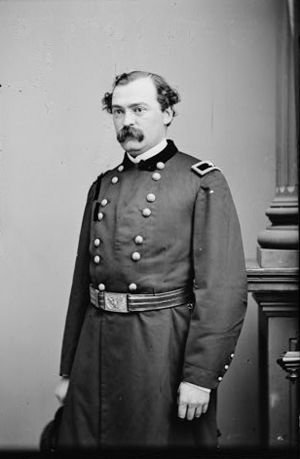James H. Ledlie facts for kids
Quick facts for kids
James Hewett Ledlie
|
|
|---|---|
 |
|
| Born | April 14, 1832 Utica, New York |
| Died | August 15, 1882 (aged 50) New Brighton, Staten Island, New York |
| Place of burial |
Forest Hill Cemetery, Utica, New York
|
| Allegiance | United States of America Union |
| Service/ |
United States Army Union Army |
| Rank | |
| Battles/wars | American Civil War |
James Hewett Ledlie (born April 14, 1832 – died August 15, 1882) was an engineer who helped build railroads in America. He also served as a general in the Union Army during the American Civil War. He is mostly remembered for his actions, or lack of them, during the Battle of the Crater.
Early Life and Work
James Ledlie was born in Utica, New York. Before the war, he worked as a civil engineer. He helped build parts of the Erie Canal. He also worked on constructing railroads.
Serving in the Civil War
When the Civil War began, Ledlie joined the Union Army. He started as a Major in the 19th New York Infantry. This unit later became the 3rd New York Artillery regiment.
He was promoted to Colonel in December 1861. A year later, in December 1862, he became a brigadier general. He was put in charge of the Artillery Brigade in North Carolina. For about a year and a half, he mostly served in safe areas. He oversaw coastal artillery defenses.
In 1864, Ledlie joined the Army of the Potomac. He commanded a brigade in Maj. Gen. Ambrose Burnside's IX Corps. On June 9, he took command of the 1st Division. This was after its previous leader was killed. It was during this time that his military career faced big problems.
The Battle of the Crater
During the Siege of Petersburg, the Union Army faced a tough situation. Former coal miners in Burnside's corps came up with a clever idea. They dug a long tunnel, 511 feet, under the Confederate lines. At the end of the tunnel, they placed four tons of gunpowder.
On July 30, 1864, the explosives were set off. This created a huge hole, or crater, about 135 feet wide. It is still visible today. The blast instantly killed many Confederate soldiers.
The Union plan was to send well-trained African-American troops into the gap. These troops, from Edward Ferrero's division, were ready to push deep into the Confederate area. However, Maj. Gen George Meade, the commander, changed the plan. He ordered a column of white troops to lead the attack instead. General Ulysses S. Grant approved this change. Meade later said he changed the order because the white troops had more experience.
Burnside was disappointed by the change. He held a lottery to pick a different division to lead. Ledlie's division was chosen. This choice led to disaster. Ledlie's division was the smallest and weakest. His soldiers were not properly told what to do. Instead of going around the crater, as Ferrero's troops were trained, they went into it.
Once inside the deep crater, they were trapped. Confederate soldiers fired down on them. Many Union troops were killed or wounded. In total, 3,798 Union soldiers became casualties. The battle did not achieve its goals.
Ledlie's reputation suffered greatly. He did not lead his men into the battle. He also did not go with them. A few weeks earlier, he had hidden during another attack. Soldiers remembered this. During the Battle of the Crater, Ledlie was seen far behind the lines.
A court looked into Ledlie's actions in September. In December, he was removed from service. This order came from Gen. Grant. Ledlie officially left the army on January 23, 1865.
After the War
After the war, Ledlie went back to being a civil engineer. He worked on railroads in the West and South. He helped build the Transcontinental Railroad for the Union Pacific Railroad.
He also worked on the Nevada Central Railroad line. He had to build 92 miles of track very quickly. His crews almost reached the city of Austin before a deadline. At the last moment, town officials extended the city limits. This allowed the tracks to meet the new boundary in time.
James Ledlie died in New Brighton, Staten Island in 1882. He is buried in Forest Hill Cemetery in Utica, New York.

